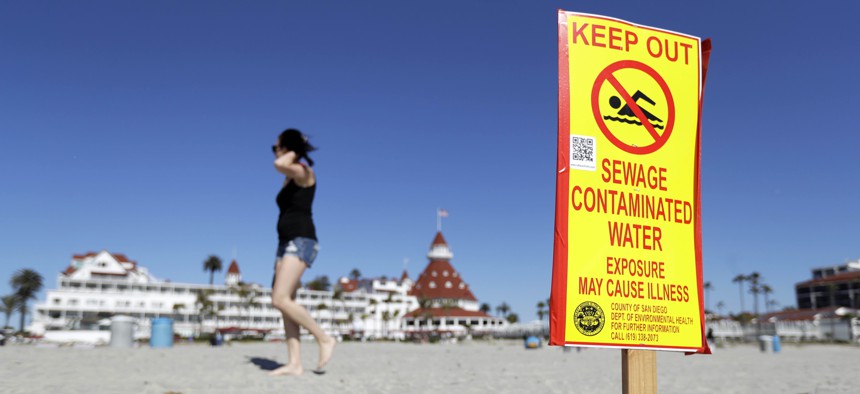County Leader Seeks to Stop Sewage Spills Along Border Amid Shutdown Fight

A sign warns of sewage contaminated ocean waters on a beach in front of the iconic Hotel del Coronado on Wednesday, March 1, 2017, in Coronado, Calif. AP Photo/Gregory Bull
With tensions high over a wall, a San Diego County supervisor is focused on funding for waterworks.
WASHINGTON — As President Trump continues his quest to secure billions of dollars for a wall on the U.S. border with Mexico, a San Diego County official sees an opportunity to advocate for spending on another type of infrastructure in the region.
During a visit to Capitol Hill on Friday, Supervisor Greg Cox, the current president of the National Association of Counties, plans to make a case for $340 million of projects meant to prevent sewage and other contaminants from flowing into waterways along the border.
His thinking is that this funding could be attached to a broader border security package. “It would be nice to see some element of that committed in whatever ultimate decision may come about in regards to border security,” he told Route Fifty on Thursday.
Cox plans to deliver his pitch when members of NACo meet with either House Speaker Nancy Pelosi, or staff from her office.
He says in a letter to Pelosi that pollution from faulty wastewater infrastructure on both sides of the border is resulting in spills that threaten public health and harm the environment.
Pelosi and other Democrats have refused to go along with the president’s demand for $5.7 billion for the wall. The deadlocked negotiations have led to a partial federal government shutdown that had stretched into its 20th day on Thursday.
In the letter, Cox describes how the area he represents has seen a “relentless barrage of untreated sewage” dumped into the Tijuana River, which crosses from Mexico into the U.S. in the southwest corner of San Diego County, before reaching the Pacific Ocean.
Cox shared a list of about 60 projects—not just in the Tijuana River watershed, but all along the border, in Arizona, California, New Mexico, Texas and Mexico—that two regional Environmental Protection Agency offices identified as possibly eligible for “border water infrastructure funding.”
The roughly $340 million estimated cost of those projects is equivalent to about 6 percent of the funding Trump is seeking for the wall.
EPA since the early 2000s has overseen what’s known as the U.S.-Mexico Border Water Infrastructure Program, which provides funding for water and wastewater projects that are within 62 miles north, or south, of the nation’s southern border.
Mexico is required to match EPA’s investments under the program in Mexican-side projects at least dollar for dollar.
The Trump administration’s budget requests have called for eliminating funds for U.S.-Mexico border water projects, a Congressional Research Service report issued last August notes.
But 2017 and 2018 appropriations bills that Congress passed and the president signed each included $10 million for such projects.
The Tijuana River flows northwest from Mexico, crossing into the U.S. near the neighborhood of San Ysidro in San Diego County, and then cuts west, winding for about six miles to the coast.
Problems with wastewater contaminating the river date back to at least the 1930s, according to Cox’s letter. One large spill in 2017 resulted in an estimated 143 million gallons of raw sewage flowing into the river and the Pacific Ocean.
The cities of Imperial Beach and Chula Vista, California, and the San Diego Unified Port District, initiated a lawsuit last March alleging Clean Water Act violations in the Tijuana River Valley.
Filed in a California federal district court, the suit was lodged against the U.S. section of the International Boundary and Water Commission, a federal entity, and Veolia Water North America, a company that contracts with the commission to operate wastewater facilities.
In December, U.S. District Judge Jeffrey Miller declined to dismiss the case—though he did partly grant motions to toss out some claims.
A court filing by the cities and the port district list human sewage, industrial waste, pesticides, trash and tires among the substances fouling waters. It also says that the beachfront in Imperial Beach was closed due to pollution over 160 days in both 2016 and 2017.
Veolia has said in previous statements it has operated a wastewater treatment plant and other infrastructure it oversees in the area in full compliance with its permits. The company has also said it’s limited by facilities that were not designed to stop or treat all of the wastewater discharges originating in Mexico that flow into San Diego County.
The equivalent of more than six million gallons a day of raw sewage was spilling into the Tijuana River at one point in early December, The San Diego Union-Tribune reported at that time.
Dozens of federal border patrol agents, meanwhile, have reportedly experienced rashes, headaches and infections blamed on contaminants and dust in the Tijuana River Valley.
U.S. Customs and Border Protection last year issued a request for information, seeking options to help cut down on these hazards.
“They’re having to traipse through not only raw sewage but toxic materials and chemicals,” Cox said of Customs and Border Protection employees working in the area.
“I’m hopeful that maybe with this crisis that we’re having in regards to getting some resolution on border security,” he added, “we can also get people that would advocate to actually try to address this problem once and for all. It’s been going on for 80 years.”
Bill Lucia is a Senior Reporter for Government Executive's Route Fifty and is based in Washington, D.C.
NEXT STORY: In States Embracing More Toll Roads, Freeways May No Longer Be Free






